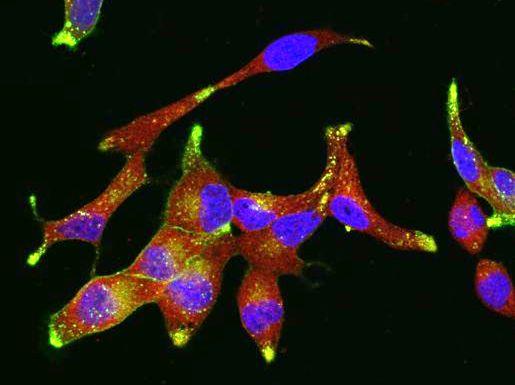- Bacteriology and Immunology
- Clinical Chemistry
- Medical Genetics
- Pathology
- Virology
- Transplantation Laboratory
- Research Programs
Contact Information
Haartmaninkatu 3 (P.O. Box 21)
FIN-00014 University of Helsinki
Finland
tel. +358 2941 911 (switch)

Plasma Exosomes As Diagnostic Biomarkers

PAP localization in TM-PAP stable-transfected LNCaP cells
Research Interests
The aim of the research is to elucidate the mechanisms behind prostatic acid phosphatase dysregulation and its effect on disease development and diagnostics. Pirkko Vihko with her research group has studied prostatic acid phosphatase (PAP) for over 30 years, and her pioneering studies among others included the development of the first enzyme radio-immunoassay (RIA) approved by the FDA, and the crystallization of the secretory isoform which represented an important milestone towards the understanding of the enzymatic mechanism. Recent findings include the discovery of the transmembrane isoform (TM-PAP) which is widely expressed in mouse and human tissues. The characterization studies on TM-PAP led to the conclusion that this enzyme is important in the regulation of vesicular traffic as revealed by its interaction with snapin (a SNARE-associated protein). TM-PAP is present in the plasma membrane and in the endosomal/lysosomal pathway including intracellular vesicles, multivesicular endosomes (MVE) and exosomes. TM-PAP exhibits 5'-ectonucleotidase activity leading to adenosine production which is effective via adenosine receptors. The PAP-knockout mice showed development of prostate adenocarcinoma which can be associated to disrupted endo-/exocytosis mechanisms. In addition, other studies showed that TM-PAP suppresses chronic pain more effective than by morphine.
Goals
The significance of all these findings moved forward the interest of the research towards the development of diagnostic methods based on the determination of TM-PAP in exosomes as a novel marker for prostate cancer in comparison with PSA measurements paying attention to their specificity and prognostic value.
Prof. Pirkko Vihko's research group collaboration network includes Finnish, European, American and Asian research groups.

PAP and snapin co-localization in stable-transfected LNCaP cells with TM-PAP (Green: PAP, Red: Snapin and Blue: nucleus)
Selected Publications
- Vihko P, Kontturi M, Korhonen LK. (1978) Purification of human prostatic acid phosphatase by affinity chromatography and isoelectric focusing. part I. Clin Chem 24: 466-470.
- Vihko P, Kurkela R, Porvari K, et al. (1993) Rat acid phosphatase: Overexpression of active, secreted enzyme by recombinant baculovirus-infected insect cells, molecular properties, and crystallization. Proc Natl Acad Sci U S A 90: 799-803.
- Schneider G, Lindqvist Y, Vihko P. (1993) Three-dimensional structure of rat acid phosphatase. EMBO J 12: 2609-2615.
- Kurkela, R., Herrala A., Henttu, P., Nal H., Vihko, P. (1995) Expression of active, secreted human prostate-specific antigen by recombinant baculovirus-infected insect cells in pilot scale. Bio/Technology (present Nature/Bio/Technology), 13: 1230-1234.
- Quintero IB, Araujo CL, Pulkka AE, et al. (2007) Prostatic acid phosphatase is not a prostate specific target. Cancer Res 67: 6549-6554.
- Zylka MJ, Sowa NA, Taylor-Blake B, et al. (2008) Prostatic acid phosphatase is an ectonucleotidase and suppresses pain by generating adenosine. Neuron 60: 111-122.
- Quintero IB, Herrala AM, Araujo CL, Pulkka AE, Hautaniemi S, et al. (2013) Transmembrane prostatic acid phosphatase (TMPAP) interacts with snapin and deficient mice develop prostate adenocarcinoma. PloS One 8: e73072.
- Araujo CL, Vihko PT. (2013) Structure of acid phosphatases. Methods Mol Biol 1053: 155-166. 10.1007/978-1-62703-562-0_11; 10.1007/978-1-62703-562-0_11.
- Street SE, Kramer NJ, Walsh PL, Taylor-Blake B, Yadav MC, et al. (2013) Tissue-nonspecific alkaline phosphatase acts redundantly with PAP and NT5E to generate adenosine in the dorsal spinal cord. J Neurosci 33: 11314-11322. 10.1523/JNEUROSCI.0133-13.2013; 10.1523/JNEUROSCI.0133-13.2013.
Contact Information:
Pirkko Vihko
MD, PhD
Professor, Chief Physician
Department of Clinical Chemistry
HUSLAB
P.O.Box 63
Haartmaninkatu 8
Biomedicum A423b
FI-00014 University of Helsinki
Finland
Tel: +358-40-5431734
Fax:+358-2941-25800
email: pirkko.vihko (at) helsinki.fi
